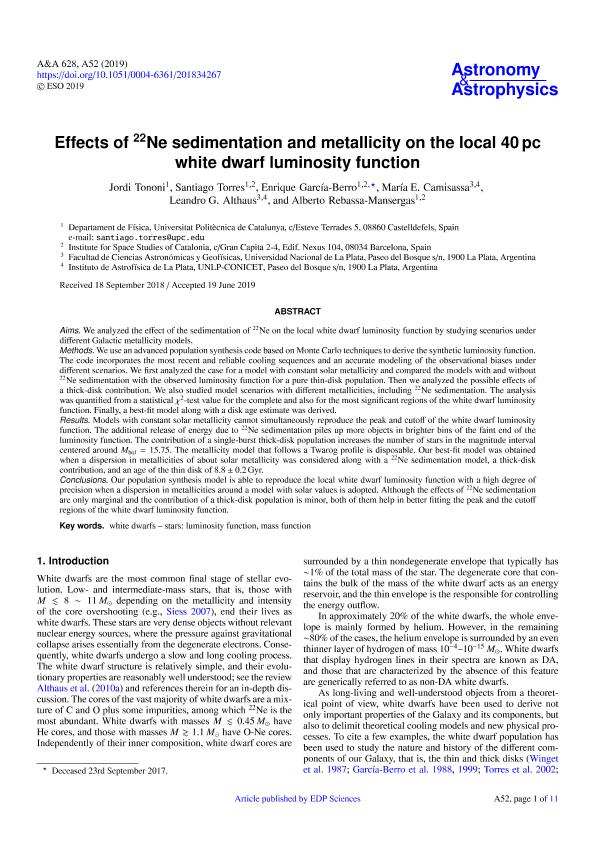Artículo
Effects of 22 Ne sedimentation and metallicity on the local 40 pc white dwarf luminosity function
Tononi, Jordi; Torres, Santiago; García Berro, Enrique; Camisassa, María Eugenia ; Althaus, Leandro Gabriel
; Althaus, Leandro Gabriel ; Rebassa Mansergas, Alberto
; Rebassa Mansergas, Alberto
 ; Althaus, Leandro Gabriel
; Althaus, Leandro Gabriel ; Rebassa Mansergas, Alberto
; Rebassa Mansergas, Alberto
Fecha de publicación:
06/08/2019
Editorial:
EDP Sciences
Revista:
Astronomy and Astrophysics
ISSN:
0004-6361
Idioma:
Inglés
Tipo de recurso:
Artículo publicado
Clasificación temática:
Resumen
Aims: We analyzed the effect of the sedimentation of 22Ne on the local white dwarf luminosity function by studying scenarios under different Galactic metallicity models. Methods: We use an advanced population synthesis code based on Monte Carlo techniques to derive the synthetic luminosity function. The code incorporates the most recent and reliable cooling sequences and an accurate modeling of the observational biases under different scenarios. We first analyzed the case for a model with constant solar metallicity and compared the models with and without 22Ne sedimentation with the observed luminosity function for a pure thin-disk population. Then we analyzed the possible effects of a thick-disk contribution. We also studied model scenarios with different metallicities, including 22Ne sedimentation. The analysis was quantified from a statistical χ2-test value for the complete and also for the most significant regions of the white dwarf luminosity function. Finally, a best-fit model along with a disk age estimate was derived. Results: Models with constant solar metallicity cannot simultaneously reproduce the peak and cutoff of the white dwarf luminosity function. The additional release of energy due to 22Ne sedimentation piles up more objects in brighter bins of the faint end of the luminosity function. The contribution of a single-burst thick-disk population increases the number of stars in the magnitude interval centered around Mbol = 15.75. The metallicity model that follows a Twarog profile is disposable. Our best-fit model was obtained when a dispersion in metallicities of about solar metallicity was considered along with a 22Ne sedimentation model, a thick-disk contribution, and an age of the thin disk of 8.8 ± 0.2 Gyr. Conclusions: Our population synthesis model is able to reproduce the local white dwarf luminosity function with a high degree of precision when a dispersion in metallicities around a model with solar values is adopted. Although the effects of 22Ne sedimentation are only marginal and the contribution of a thick-disk population is minor, both of them help in better fitting the peak and the cutoff regions of the white dwarf luminosity function
Palabras clave:
white dwarfs
,
stars: luminosity function
,
mass function
Archivos asociados
Licencia
Identificadores
Colecciones
Articulos(IALP)
Articulos de INST.DE ASTROFISICA LA PLATA
Articulos de INST.DE ASTROFISICA LA PLATA
Citación
Tononi, Jordi; Torres, Santiago; García Berro, Enrique; Camisassa, María Eugenia; Althaus, Leandro Gabriel; et al.; Effects of 22 Ne sedimentation and metallicity on the local 40 pc white dwarf luminosity function; EDP Sciences; Astronomy and Astrophysics; 628; A52; 6-8-2019; 1-11
Compartir
Altmétricas



